The Northern Salvo
Incorporating Weekly Notices, Sectional Appendices, and Northern Weekly Salvo
Published at Station House, Kents Bank, Lancashire-North-of-the-Sands, LA11 7BB and at 109 Harpers Lane, Bolton BL1 6HU (Lancashire-South-of-the-Sands)
email: paul.salveson@myphone.coop
No. 315 November 2023
Salveson’s half-nakedly political digest of railways, tripe and secessionist nonsense from Up North.
Railways in turmoil
It has been an interesting few weeks for the railways, despite being overshadowed by the tragic events in the Middle-East. The scrapping of HS2 north of Birmingham has been greeted with predictable outrage. In this Salvo we take a more measured view of Sunak’s announcement at Conservative Party Conference, with some very good reader responses. The really good news has been the Government’s U-Turn on ticket office closures. Despite the weasel words from Government suggesting that it was a ‘the train companies’ fault’, this was a plan driven by Government. Don’t forget that the proposals did not extend to Wales, Scotland, Merseyrail or London Overground, where the Department for Transport isn’t responsible for regional railways. 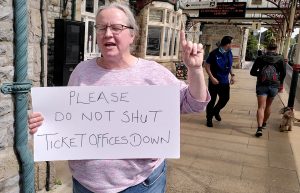
Bizarrely, one of the few stations down to lose its ticket office in Scotland was Glasgow Central! That was because it’s operated by Avanti West Coast, a contract managed by the (London-based) DfT. We should be careful about being too complacent following the U-Turn. The Treasury will still be after ‘savings’ in the rail budget and the Ticket Office victory was down to strong lobbying and political pressure, uniting unions, community groups and transport campaigners. If there had been that sort of united response to the Beeching closures of the 1960s, our railways would look very different today. I won’t labout the HS2 farce in this issue: the comments from readers (‘Top Feedback’) give a good overview of the issues. While I always argued that it was very poor value for money and potentially destructive for the North, siphoning a large chunk of the money saved into roads schemes isn’t the way we should be going.
Small changes at The Salvo, no need to panic
I’m making some small changes to The Salvo’s production. The main change is that the website hosting The Salvo will change from www.lancashireloominary.co.uk to www.paulsalveson.org.uk
The change should take place with issue no. 316 but I’ll keep you posted. The Lancashire Loominary website will be closed down and I’ll concentrate all my own stuff on www.paulsalveson.org.uk, which is currently devoted to photographs (have a look, there’s some nice stuff there, but a lot of it will be removed). The consolidation is partly driven by having another website to manage now, for the Station Library (see below) as well as realising that the photographic website was not getting much use.
Railways and Music
Links between railways and music go back a long way and the connections have been well-documented. We all love Strauss’s ‘Excursion Train Polka’ and Honegger’s ‘Pacific 231’. But there is also a less recognised tradition, which includes the work of some ‘classical’ composers as well as folk song.
This survey of British music ‘with a railway connection’ does not pretend to be comprehensive and reflects the author’s own tastes. I’ve tried to highlight the contributions of railway men and women to music, mainly as performers, and the contribution of the industry to music.  While the focus is very much on Britain, I should mention Julius Beliczay (1838 -1893), a senior engineer with Hungarian State Railways (MÁV) and an accomplished composer. I’ve a CD of his Symphony in D Minor performed by the MÁV Symphony Orchestra in 1996. The orchestra was formed after the Second World War and was originally composed of working railway employees who mostly performed for railway audiences around major railway centres in Hungary. Today, it is a professional orchestra with an international reputation.
While the focus is very much on Britain, I should mention Julius Beliczay (1838 -1893), a senior engineer with Hungarian State Railways (MÁV) and an accomplished composer. I’ve a CD of his Symphony in D Minor performed by the MÁV Symphony Orchestra in 1996. The orchestra was formed after the Second World War and was originally composed of working railway employees who mostly performed for railway audiences around major railway centres in Hungary. Today, it is a professional orchestra with an international reputation.
But back to the UK. There is fascinating history of railway company support and sponsorship for bands, orchestras and choirs. As early as the 1860s there was a Great Northern Railway ‘Glee and Madrigal Society’. Other companies supported operatic societies and even orchestras. Why did they do it? Undoubtedly it was partly from a sense of encouraging employees to be involved in ‘uplifting’ activities which kept them out of the pub. A form of social control. But there was also a sense of encouraging company pride, as well as what we would recognise today as a form of marketing and promotion.
There are many examples of railway brass bands. The nature of railway work tended to limit the involvement of shift workers, whose hours of work would have made it impossible to co-ordinate a large ensemble. So it’s not surprising that most railway brass bands tended to be based at the larger workshops. The Lancashire and Yorkshire Railway opened its engineering works at Horwich in the mid-1880s and encouraged recreational activities. The Railway Mechanics’ Institute developed as a cultural as well as a technical centre and the RMI Band became a nationally-respected ensemble, winning the British Championship at Crystal Palace in 1922.
The North Eastern and Great Northern Railways did much to support employees’ recreational activities and H.V. Ivatt, the chief mechanical engineer of the Great Northern between 1895 and 1911, was a well-known music enthusiast. His daughters often gave piano recitals at railway social events.
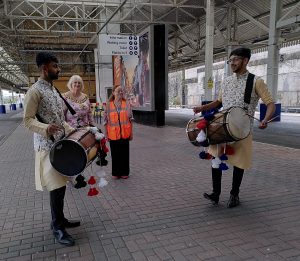
When the London and North Eastern Railway was formed in 1923 it didn’t take long for an LNER Music Society to be formed, which acted as an umbrella body for a choir and full orchestra. The LNER also sponsored its own Silver Band which performed at events such as the Darlington Railwaymen’s Carnival during the 1920s and 1930s.
Some of the pre-grouping railway music groups merged after 1923 and the formation of ‘The Big Four’ companies. The South Eastern and Chatham Railway had a Military Band and Orchestra while the London and South Western had a Musical Society. They amalgamated in 1925 to form the Southern Railway Musical Society, under the patronage of the General Manager.
Chudley Candish was a professional railwayman and composed The Song of the Jolly Roger. Sebastian Meyer, Assistant General Manager of the Hull and Barnsley wrote A Holiday Reminiscence for the company’s Railway’s Choral Association in 1887. Hubert Bath, a minor English composer, wrote the cantata for men’s voices Men on the Line for the Great Eastern Railway.
Some larger railway centres had their own bands, including Doncaster, York and Bletchley. The Bletchley Station Band often performed at union events and demonstrations. Generally, the railway unions did not have their own musical bodies though in recent years the RMT union sponsored Easington Band, in Co. Durham, and encouraged the band to play at RMT demonstrations. 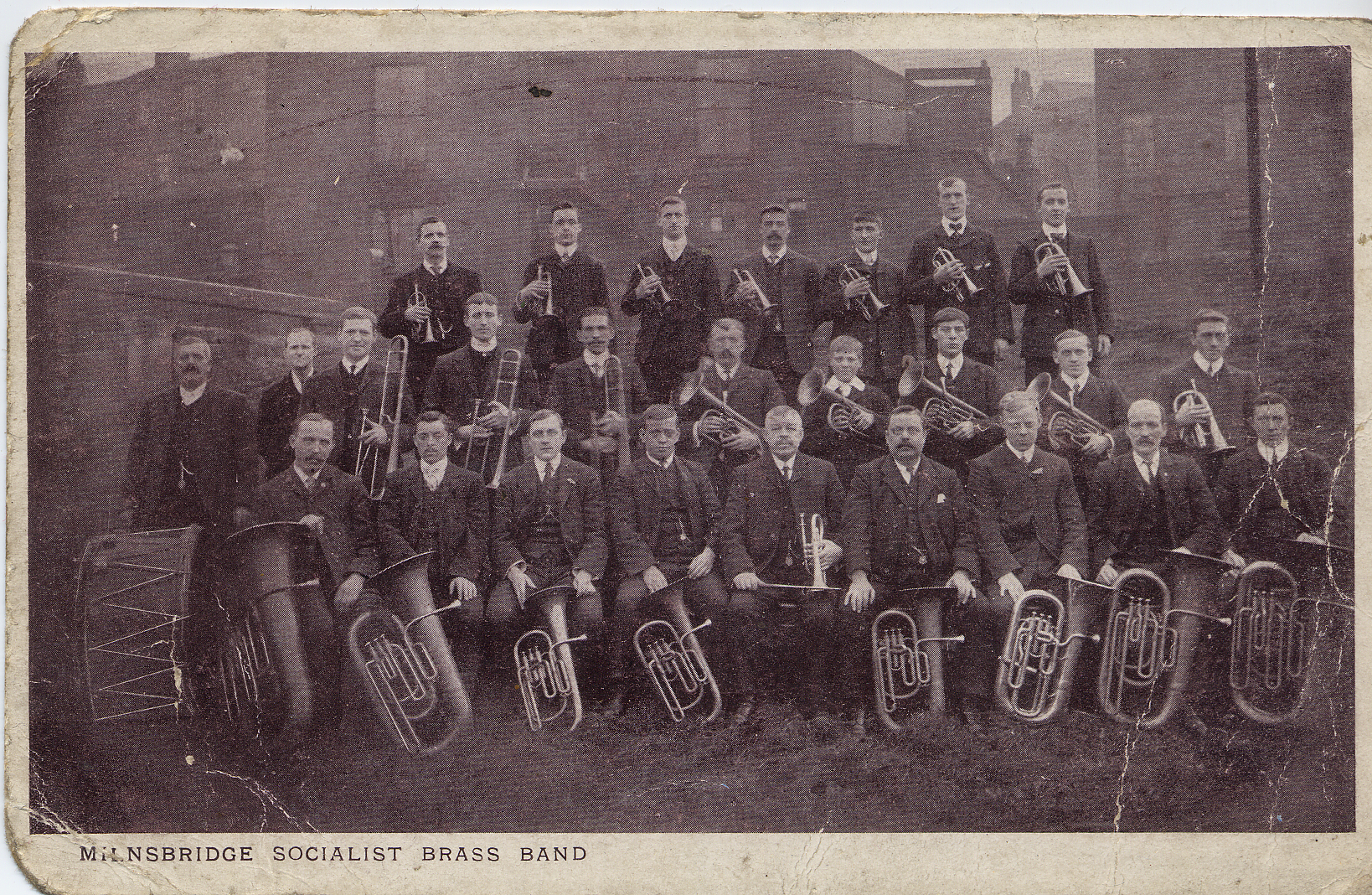 There was a Doncaster NUR Band in the 1920s but it does not seem to have lasted for very long. The York Railway Institute Band, with a history stretching back to 1883, is a great survivor, along with the institute that supports it. As recently as December last year it gave a performance of Mozart’s Requiem with Skipton Choral Society in Selby Abbey.
There was a Doncaster NUR Band in the 1920s but it does not seem to have lasted for very long. The York Railway Institute Band, with a history stretching back to 1883, is a great survivor, along with the institute that supports it. As recently as December last year it gave a performance of Mozart’s Requiem with Skipton Choral Society in Selby Abbey.
Hundreds if not thousands of songs have been written about railways; however, it is not so easy to find many that were written by working railway people. Dave Goulder, a former loco fireman from Kirkby-in-Ashfield, is an exception. He wrote and performed songs about railway life which capture that period around the end of steam. In Requiem for Steam he sang a lament for the end of an era, from the point of view of one of the many who were thrown on the scrap heap:
Well I’ve given me kettle and me old tin can
To a lad for a souvenir
And I’d trade in me shovel for twenty fags
Or the price of a bottle of beer
For the Scotsman has come to the end of his run
And Mallard is cold as the stone
The story is over, the giants are dead
And the jackals are picking the bones
The English ‘Folk Song Revival’ of the 1850s and 60s produced The Ballad of John Axon, written by Ewan McColl and performed with Peggy Seeger. The ‘radio ballad’, one of a new approach to broadcast folk music, was based on the life and sad death of Stockport driver John Axon in February 1957. 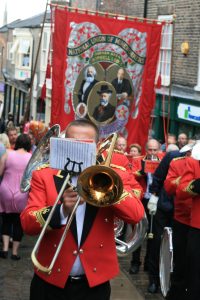 While driving a Stanier 8F on a heavy goods train from Buxton to Stockport the train ran out of control after the steam brake failed, enshrouding the cab in scalding steam. Axon stayed in the cab after telling his mate to jump for his life. Axon died in the ensuing collision at Chapel-en-le-Frith. The LP (and subsequent CD) The Ballad of John Axon includes some songs that McColl wrote himself but also some he collected as part of his research in the Manchester area. More railway songs appeared on Steam Whistle Ballads including one song he learnt from an old railwayman at Newton Heath depot. Moses of the Mail is a light-hearted tale of woe about a Lancashire and Yorkshire driver whose journey from Manchester through the Calder Valley to Yorkshire goes sadly wrong. However, McColl was no locomotive expert and he wrote some of the terms down incorrectly. For example one line goes ‘both front fenders failed to work, and the engine wouldn’t steam’ instead of ‘both injectors’ (though sometimes it’s given, more possibly, as ‘sanders’). The error has been perpetuated in countless folk clubs across the North! Here’s how I think it should be sung (first two verses):
While driving a Stanier 8F on a heavy goods train from Buxton to Stockport the train ran out of control after the steam brake failed, enshrouding the cab in scalding steam. Axon stayed in the cab after telling his mate to jump for his life. Axon died in the ensuing collision at Chapel-en-le-Frith. The LP (and subsequent CD) The Ballad of John Axon includes some songs that McColl wrote himself but also some he collected as part of his research in the Manchester area. More railway songs appeared on Steam Whistle Ballads including one song he learnt from an old railwayman at Newton Heath depot. Moses of the Mail is a light-hearted tale of woe about a Lancashire and Yorkshire driver whose journey from Manchester through the Calder Valley to Yorkshire goes sadly wrong. However, McColl was no locomotive expert and he wrote some of the terms down incorrectly. For example one line goes ‘both front fenders failed to work, and the engine wouldn’t steam’ instead of ‘both injectors’ (though sometimes it’s given, more possibly, as ‘sanders’). The error has been perpetuated in countless folk clubs across the North! Here’s how I think it should be sung (first two verses):
It was a dark and stormy night, the snow was falling fast
I stood on Thorpes Bridge Junction where the reckless Moses passed.
His hair was widely waving as through the air he sped;
He’d never had such doings since he started at the shed.
The signals on at Newton Heath – the shed was close at hand
He sent his mate for some more oil and a couple of bags of sand
At Moston’s dreary cutting the struggle was extreme
Both injectors failed to work and the engine wouldn’t steam…..
Another outstanding song about the Beeching era, written by former booking office clerk ‘Stanley Accrington’ was The Last Train. A retired railwayman dreams about his life on Lancashire’s railways before the axe came down, and then wakes:
Down the Rossendale Valley on a sultry warm day
The clanking of wheels echoes on
But it’s all in my mind, when I wake up I find
That the last train from Bacup has gone…….
Stanley himself describes his first gig, in appropriate surroundings, when “he finally plucked up the dutch courage to perform in front of real people in August 1979 at the Buffet Bar at Stalybridge Station, a local live music venue. No one heckled and some applauded, so he knew he was on the right lines, as it were.” He’s still going yet. Stanley performed Last Train on a memorable night on the Penistone Line ‘Folk Train’ some years ago.
What must count as a unique event in the history of railways and music was the collaboration between Northern and the Royal Northern College of Music, on June 22nd 2008. Part of Newton Heath Train Depot (‘The Parlour’ as it has been known for generations) was converted, for an afternoon only, into a concert hall. Northern Brass – a musical celebration of railways in the community -brought together two brass bands to perform a selection of railway-themed music, including a specially-written piece called Newton Heath Variations, by young composer Lucy Pankhurst.
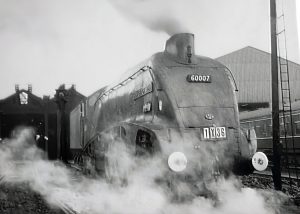
The finale featured the opening of the shed doors and the appearance of preserved Barclay saddletank May steaming slowly but majestically into the ‘concert hall’, with whistle blowing! It was one of the most exhilarating experiences of my life and thrilled the audience, drawn from railway families and community rail activists.
The punk band Blyth Power, named after a class 56 diesel loco, perform some great railway songs, including Junction Signal and Signalman White. I’m sure there’s a lot more out there, with bands playing local gigs and promoting a railway message. Nominations welcome, especially if they include working railway people. Surely there’s an opportunity out there for the train companies, or Great British Railways, to nurture the huge talent that exists within Britain’s railway community? One shining example in recent years was TransPennine Express, whose employee choir delighted audiences for several years before its disbandment.
There’s so much more the industry could do to encourage the talent within its ranks, as well as supporting young people’s musical development and sponsoring bands, orchestras and individual musicians. They’d be following a long and honourable tradition which helps place railways where they should be – at the heart of society.
I am grateful to the work of Philip Scowcoft for some of the background to this article.
A Railway Library on a Railway Station
Following the Government U-Turn on ticket office closures, it’s a good time for creative ideas on what to do with our stations that helps them become community hubs.
Kents Bank, on the Furness Line between Carnforth and Barrow, is an example of what can be done. It’s now home to a library devoted to railways and transport, with an emphasis on the social side of railways. 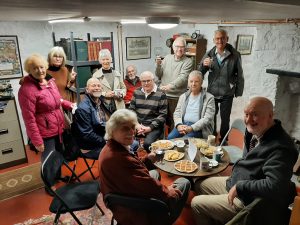 It’s run by Salvo editor and co-owner of the Station House, Prof. Paul Salveson, and is based on his extensive collection of railway books, numbering over 3,000 titles. Over the last few months it has expanded thanks to several donations, including some from railway staff, delivering books from trains!
It’s run by Salvo editor and co-owner of the Station House, Prof. Paul Salveson, and is based on his extensive collection of railway books, numbering over 3,000 titles. Over the last few months it has expanded thanks to several donations, including some from railway staff, delivering books from trains!
“We are in the process of setting up a not-for-profit community interest company (CIC) to develop the library,” said Paul. “Once the CIC is established, the collection will be vested in the company, which may become a charity.”
All the collection is now shelved and categorised. A longer-term project is to get every item catalogued. The collection includes a full set of The Railway Magazine from 1897 to 1980, and some rare bound volumes of railway trade union journals going back to the 1890s. A website went live two days ago: www.stationlibrary.org.uk
The library is primarily for reference though there is a small lending section.  Visits are by appointment (or pot luck!) but there will also be a monthly open day, on the first Saturday of each month starting in 2024. A preview ‘open day’ was held on Saturday October 21st and attracted over sixty visitors. The only down side was the non-appearance of Bulleid Pacific on a railtour – it slipped to a stand on Dalton Bank, causing widespread disruption to other services. It finally came storming through Kents Bank over two hours late. You just can’t trust these Bulleids. The next event has been organized to avoid any incursions or excursions by Southern locomotives.
Visits are by appointment (or pot luck!) but there will also be a monthly open day, on the first Saturday of each month starting in 2024. A preview ‘open day’ was held on Saturday October 21st and attracted over sixty visitors. The only down side was the non-appearance of Bulleid Pacific on a railtour – it slipped to a stand on Dalton Bank, causing widespread disruption to other services. It finally came storming through Kents Bank over two hours late. You just can’t trust these Bulleids. The next event has been organized to avoid any incursions or excursions by Southern locomotives.
“We are holding a pre-Christmas event on Saturday December 9th, jointly with The Beach Hut Gallery, next door. There will be mince pies, mulled wine and soup,” said Paul. “Our first talk, in the Reading Room, will be about Irish Railways in the 1950s, by Michael Davies. It’s on Tuesday evening December 5th, starting at 7.30. Admission is free but must be pre-booked by phone or email.” (see below).
Although use of the library is free and open to all, it is planned to develop a subscription offer where members receive a newsletter, notice of events and talks and discounts on book sales.
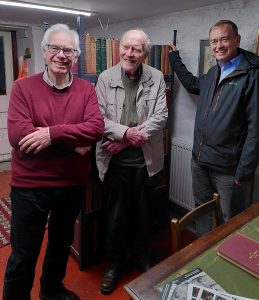
The individual subscription will be £25 a year, with a higher corporate subscription. Donations of books are very welcome.
Maybe the next step should be to get a station cat.
Contact details: Paul Salveson on 07795 008691 or info@stationlibrary.org.uk
Postal address: Station House, Kentsford Road, Kents Bank, Grange-over-Sands LA11 7BB
Website: www.stationlibrary.org.uk.
After the U-Turn: can we transform the ‘ticket office’?
The recent announcement that the mass closure of ticket offices, mostly in England, has been abandoned is great news. But let’s not get too complacent: whilst the immediate threat has gone there will be a risk of ‘closure by stealth’ as train companies are encouraged by Government to take a more incremental approach to booking office closures.
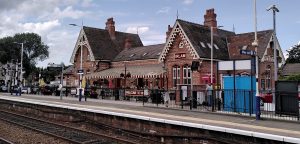
Let’s look at some of the issues, and the opportunities this week’s announcement offers. What was singularly lacking in the announcement was any commitment to looking at ways of making more use of our stations. At least RMT, in its announcement welcoming the U-Turn, recognised this.
There is no doubt that more and more rail passengers are buying tickets on line. This is in the face of persistent advice from me (mainly to my daughters) who think, often wrongly, that they get a better deal ‘going on line’. That trend will continue. But we still need that staffed presence, but perhaps doing other things than just selling tickets.
What we offer ‘customers’ at staffed stations is often a less-than-ideal experience, having to communicate with someone stuck behind a window who can sometimes present, without intention, the image of unfriendly officialdom. It’s a system that even most banks have done away with.
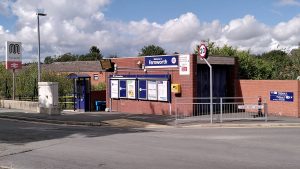
For so many journeys involving different options in the kind of ticket purchased, being able to talk to a real live person sat alongside you is important. For larger stations, we need to keep a decent number of highly trained and well-motivated staff, with good language and inter-personal skills.
But what of the small station which might have a footfall of around 200,000 passengers a year and may offer nothing more than a single person doing a 6-2 shift? Many stations around the North fall into that category, and the member of staff may only be dealing with a couple of trains an hour with passengers bunched within a few minutes of the trains’ departure.
“Close them,” the bean counters will say. But there are other ways. Think about it, how barmy is it that someone is sat there in a ‘booking office’ selling only one product (i.e. rail tickets)? Can you imagine a petrol station selling nothing other than petrol?
One experienced professional told me “a station is the railway’s shop window and is now more than ever a loss-leader like milk in a supermarket. Yes it can sell tickets but can also provide useful information about rail travel, plan journeys, de-mystify tickets types, provide details of onward connections, advise about bus links, be a source of local information and be that reassuring presence for passengers wary of travelling by train.”
Merseyrail piloted a pioneering scheme some years ago called ‘M to Go’, with their partner Merseytravel and with union agreement. It was based on experience on Netherlands Railways (NS) – the ‘wizzl shop. This involved some ‘booking offices’ being transformed into convenience stores. Merseyrail staff would sell rail tickets but also a range of other products. From what I’ve heard, the scheme has generally worked well, though it is very location specific – like any other retail business. Some locations have worked well, others less so.
City-region transport authorities such as Transport for Greater Manchester or West Midlands Rail Executive could take over the running of smaller stations and develop them along the ‘M to Go’ lines, where the location is right. I suspect the train company would be glad to co-operate. Having a substantial public body like TfGM or WMRE taking over responsibility for smaller stations would ensure economies of scale in procuring goods as well as ensuring high customer care standards and staff conditions. Depending on location, there may be scope for extended opening hours and more staff, including use of part-timers.
There is potential for the rail industry working in partnership with convenience store ‘chains’ such as the Co-op, Post Office or others. This has been tried in the past, in the south-east. Again, it’s location, location, location.
There is a ‘community rail’ angle to this. A few stations (e.g. Gobowen and Millom) have staffed booking offices run by a social enterprise. I’m talking about paid staff rather than volunteers.
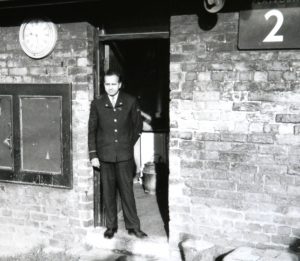
That could work in several locations, including stations outside the larger combinations without the benefit of a regional transport body like TfGM but possibly with an active community rail partnership (CRP). There is scope for using new products at stations. Payzone now have a fully functional rail ticketing module which is cheap to operate and also offers all the other Payzone modules such as mobile phone top-up and payment of utility bills.
There are quite a few stations that could develop this way, with the support of an active CRP or ‘station partnership’. I would stress that it is heavily dependent on location and footfall, what else is in the immediate vicinity. It makes neither commercial nor social sense to set up shop in competition with a similar place across the road.
One station in my area (Lostock: a re-opening of the 1980s) has a busy commuter flow as well as leisure trips. It serves what was an old mill village which has been transformed into an attractive place to live with a lot of nearby housing development. Yet there are no facilities. The old corner shop and post office closed when the mill shut, leaving nothing. The under-used ‘booking office’ could provide a much wider range of facilities and services.
In some cases where a station is only partly staffed , as an alternative to de-staffing it and losing an important community asset, why not hand it over to the community to develop? This is a model that is growing in popularity, with a number of shops and pubs being handed over to community-owned businesses. There is money to help. The Government – sponsored Community Ownership Fund’s objectives include help to:
- acquire a physical community asset at risk, such as land and buildings which deliver a benefit to local people
- renovate, repair or refurbish the asset, only where it is a community asset at risk of closure and where this is critical to saving the asset and making it sustainable for long-term community use
- set up a new community business or buy an existing business in order to save an asset of importance to the community
(https://www.gov.uk/government/publications/community-ownership-fund-prospectus/community-ownership-fund-prospectus–2)
Could existing employees, working with the local community, set up a community business if there was the right support (finance, training) available? A CRP could help to get the process off the ground, possibly as a subsidiary business. As president of my community rail partnership (South-East Lancashire) I’d shy away from my CRP taking on the direct running of a station shop, but we could offer support and advice, with help in promotion and marketing (just as we do with our sponsored bus services).
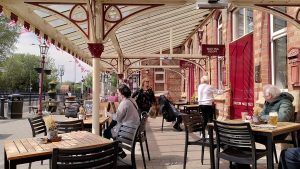
There should be a clear contract on what would be expected and a favourable rent, but outside of mainstream regulation. Grants should be available (as above) to take on the station shop with structural changes made to the lay-out of the building to bring it into line with what we expect from an attractive small shop.
It’s about applying ‘corner-shop economics’ to a small station, where the people running it are part of the community and able to exploit opportunities and develop a valuable range of services.
Using this model, there would be a case for bringing quite a few currently unstaffed stations back to life. In my own neck of the woods, I would nominate stations such as Westhoughton, Mills Hill, Slaithwaite, Marsden and Mirfield.
We should not be deterred by the absence of buildings. There are examples, such as Ludlow and more recently Llandeilo, where a new station building has been provided. There are lessons to be learned from that experience (it wasn’t easy) but the basic concept was right. The cost could be brought down by having a simple but attractive modular design approved by Network Rail/GBR.
To re-cap, we’re talking about four categories of station, viz.,:
- Category 1: Large station, staffed by train company (or GBR possibly), with specialist advisers, including offering one-to-one travel advice (multi-modal), with other retail facilities available within station.
- Category 2: Medium-sized station, possibly with combined ticket sales and some retail, staffed either by the train company or a transport body such as TfGM, WMRE, Merseytravel etc. Could also do bike hire and other services depending on location..
- Category 3: Small station, staffed by employed agents as above, providing a mix of rail tickets and other retail. In tourist areas there is scope for doing a range of tourism-related products and sales. There could be potential for involving a retail partner, e.g. Co-op, Post Office, or similar, in this category.
- Category 4: ‘Community Station’ run independently by a social enterprise, small business or similar, offering perhaps a limited range of rail tickets and advice, plus ‘local shop’ functions and other goods depending on location. Local post office? Village cafe? Art gallery and shop? The possibilities are endless. It’s about applying ‘corner-shop economics’ to a small station and being at the heart of the community..
The experience so far of independently-run booking offices is mixed and we need to learn from that. If independent station shops are to sell tickets, they need to be properly re-imbursed. They must be disentangled from the red tape that surrounds rail ticket retailing and booking office opening times. There should be public funding (capital for setting up costs and initial revenue support while the business gets established) for staffing smaller stations where there is a demonstrable community benefit. Stations have potential to be community hubs in so many ways and that should be recognised through start-up funding.
There is already quite a lot of thinking about these questions going on in the rail industry behind the scenes; this is a contribution to what should be an ongoing debate informed by some serious research. Staying as we are is not a long-term, or even medium-term, option.
Salvo Shorts
Dear friends departed
I’m very sorry to have to report the deaths of two good friends. Paul Blackburn, a talented poet, died unexpectedly in his sleep a few weeks ago. His funeral was well attended by friends and comrades going back many decades. Noel Spencer, former shop steward and Bolton councilor (including a stint as mayor) died three weeks ago and his funeral is on November 9th. I’ve many fond memories of Noel back in the 1980s, campaigning for the people of Farnworth. My love and very best wishes to the families of Paul and Noel: both made a great contribution to Bolton and its culture and politics, although in very different ways.
Station of Sanctuary: wonderful walk Wigan-wards
The development of Bolton as a ‘station of sanctuary’ – a friendly, welcoming place for refugees and asylum seekers, is coming along well. Last Saturday the local City of Sanctuary together with the community rail partnership, station partnership and Friends of Hindley Staion
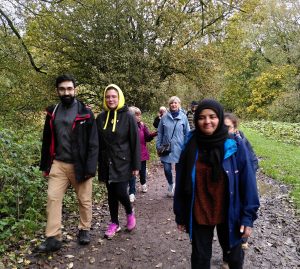
organized a very well supported walk along the new Community Rail Trail from Westhoughton to Hindley. The walk runs from Bolton to Wigan, via Lostock, Westhoughton, Hindley and into Wigan. Over forty of us took part, the weather was fine and we had an excellent lunch at the Eddington Arms, next to Hindley station, on arrival.
Railway villages
Thanks to everyone who chipped in suggestions following the last Salvo. Malcolm Bulpiit wrote: “Melton Constable on the MGNJR in Norfolk, it lived and died with the railway. Lostwithiel in Cornwall was an ancient town but the Cornwall Railway put their C&W works there and it then became a railway village. Newcastleton on the Waverley Route only existed due to the railway. There are many, many, more. Get scribbling.”
I will! More suggestions welcome. To qualify as a village I suppose it needs a bit more than just a row of houses, and ideally include shops, schools or church. But not necessarily. Some larger places, including cities, have several railway villages within them, including Carlisle, which has at least four examples (Currock, Durranhill, Kingmoor and Upperby) reflecting the different companies presence in the border city. Woodford Halse would qualify, and there’s a good Oakwood Press book about it. There must be lots scattered around London, e.g. perhaps Bricklayer’s Arms, Camden, Kentish Town. Suggestions please!
Birthday treat to Beamish
I know how to have a good time: playing trains, trams and going down t’pit, followed by a pint. Most if not all these pleasures can be enjoyed at Beamish, the wonderful open-air museum near Stanley, Co. Durham. The last time I was there was 1982, not that long after it had opened. My, what a transformation!

It’s fabulous place, and immensely popular. The basic idea was to re-create a classic Durham mining community, round about 1900. Several buildings, including an entire terraced row of houses, were taken down brick-by-brick and re-built on the large site. There’s a coal mine, railway (well two really), a co-op store, pub and lots more. A more recent development has been the creation of a 1950s community, with modern (for its day) council housing and even a slag heap. The whole thing is connected by tram, performing a circuit around the site, supplemented by heritage buses. Sunday afternoon was spent looking round Bishop Auckland – including a visit to the new Faith Museum and the excellent Museum of Mining Art. A town definitely ‘on the up’. Other treats over the weekend included a visit to Locomotion at Shildon for the model railway exhibition and Ripon Cathedral, where I had the pleasure of meeting up with old railway pal Phil Bustard, now a verger in the cathedral.
And Blackpool
Nice to meet up with another old pal this time in Blackpool. I’m always drawn back to Blackpool, especially this time of year, with ‘Th’Lights’. A nice lunch was had and as we headed back to the station we came across a really interesting place, which I can recommend to visitors and locals alike. It’s called ‘Aunty Social’ and is a shop full of fascinating things, made by local artists and ‘makers’. It has a radical edge to it, and I bought a Walter Crane reproduction poster celebrating ‘The Co-operative Commonwealth’.
Lancastrians: Mills, Mines and Minarets
More talks are planned on aspects of my new book on Lancashire history and identity. The gg at University of Central Lancashire, in Preston, was very well supported with about 60 people attending, a nice mix of students, academic staff and local people.
The next sessions are:
- Clarion House AGM, Nelson – Unity Hall, 14.00 Saturday November 18th
- Bolton Socialist Club, Friday November 24th at 19.30
- Edwin Waugh Dialect Society, Rochdale, January 9th at 19.30 (switched from Nov. 14th)
Please contact me if you would like more details.
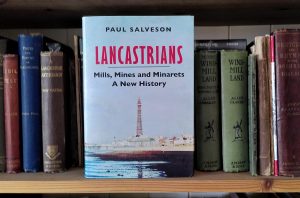 The book isn’t a ‘conventional’ history and covers different theme sof Lancashire history, including sport, culture, politics, industry and religion. It explores the Lancastrians who left for new lives in America, Canada, Russia and South Africa, as well as the ‘New Lancastrians’ who have settled in the county since the 14th century. There are about forty ‘potted biographies’ of men and women who have made important (but often neglected) contributions to Lancashire.
The book isn’t a ‘conventional’ history and covers different theme sof Lancashire history, including sport, culture, politics, industry and religion. It explores the Lancastrians who left for new lives in America, Canada, Russia and South Africa, as well as the ‘New Lancastrians’ who have settled in the county since the 14th century. There are about forty ‘potted biographies’ of men and women who have made important (but often neglected) contributions to Lancashire.
It’s available, published by the highly-respected publishers Hurst whose catalogue is well worth a look at it. See https://www.hurstpublishers.com/catalogues/spring-summer-2023/.
The book is hardback, price £25. Salvo readers can get a 25% discount by going to the publisher’s website (www.hurstpublishers.com) and enter the code LANCASTRIANS25 at checkout.
Top Feedback: HS2
Some very supportive/intelligent responses to the last Salvo on HS2 cancellation: thank you. Here’s a selection of comments, which take differing approaches but all have validity:
Mark Barker says: The Government’s list of goodies needs to be treated with a degree of suspicion:
- The named rail schemes are uncosted, whereas there are specific sums for road schemes, presumably these are more developed than the rail schemes. So how much of the £36 bn does rail get? This despite the fact that the rail schemes are known about, but unsupported by DfT, such as ‘Restoring Your Railway’, or major upgrades such as Ely remodelling.
- Over £23bn is allocated to City Region Sustainable Transport or Local Transport funds. Is this ‘new money’ and how will these funds be allocated? Will this be a City Region or DfT decisions?
- There is a lot of double counting going on, for example, the same ‘pot’ of money being mentioned in different regional sections e.g. £2.2 bn for local transport projects mentioned in East Midlands and West Midlands, and £4.0 bn for linking Northern cities mentioned in Yorks & Humber and North West. Some projects are mentioned twice; eg Leamside line and Leamside new station, Tavistock station and five miles of new line. Yes, there are some worthwhile, even important schemes mentioned eg Ely remodelling, but there are some notable absentees eg Colne-Skipton, the western part of Northern Powerhouse (Liverpool to Manchester Airport), or any freight infill electrification schemes. Above all, nothing at all to address capacity on the WCML north of Handsacre and on the approaches to Manchester
David Horsman: Paul, We have been vindicated though after a terrible waste of money.We told them that HS2 was not going to provide an up to date integrated transport system for the country which we desperately need. So our efforts were not in vain and we were RIGHT !
Malcolm Bulpitt: HS2 should have been called ‘London’s Crossrail Two’. It was a political vanity project that only existed to bring more people into the capital. Why else would the Westminster Village have approved it? Anyone north of Watford who thought otherwise was soft in the head. Looks like most of the money ‘saved’ is going on political bribes. A sort of 21stC ‘Bread and Circuses’.
John Yellowlees: Sorry, Paul. This is a dark day for rail investment. Costs will now soar as bidders price in uncertainty. You can’t just switch projects in mid-development without huge wastage, and Bradford is simply in the wrong place to be on the Trans Pennine main line. Another huge victory for the roads lobby from a millionaire Prime Minister who has no sympathy for public transport.
Stewart Arnold: It all stems from the lack of regional governance in the North. If the Government had gone to a Yorkshire Parliament at the outset and asked what are your top 10 transport priorities, nowhere would have getting to London 20 minutes quicker appeared. As it was, without a regional structure in place, Westminster decided they knew best and so HS2 was born. The betrayal thing is a bit wearing I agree. It hadn’t been coming to Yorkshire for quite some time now and I don’t remember the same sense of outrage from Labour Mayors. However, the North was promised a part of one of the largest infrastructure projects in recent times and for that to be scrapped feeds into a narrative of indifference when it comes to how Westminster sees the North. I’d get behind a fast direct route from Hull to Manchester Airport though!
Mike Pedler: I agree with you Paul on HS2 but also with Vince Chadwick and maybe with John Yellowlees that this is a victory for the roads lobby. I never believed HS2 had anything to do with that mythical kingdom “The North”, but I struggle to believe that we will get the promised schemes even if Labour adopts the plan. Regarding the Hope Valley line, it has taken us 7 or 8 years just to get rid of some single tracking and build a passing loop. What chance of electrification?
John Kolodziejski: I was against HS2 from the start for the same reasons you have clearly adduced. I think Burnham et al were wrong-headed in backing HS2 unless it was a cunning, far-sighted plan to get what the Tories are now saying they’re offering for Northern Power House Rail. HS2 was a ‘big sell’ offering jam which will only be savoured some 15 to 20 years of tomorrows. Most of today’s keen rail travellers (e.g.myself) are opting reluctantly for the comfort and predictability of our own four rubber wheels. Burnham should have campaigned incessantly for the debottlenecking the obvious distinctive regional obstacles to reliable services ie Castlefield Corridor…..at least i’d have something to look forward to in my lifetime.
Robert Snape: Restoration of the double track of the Manchester to Blackburn route is essential. The railway to Clitheroe and that to Colne depends on a single line for much of its length to connect it to the region’s economic and cultural hub. The extension of a passenger service from Clitheroe to Hellifield would also create a second route to Carlisle. In this case the track is already there and being used by freight traffic. We have been waiting for these things for decades. If we don’t get them in this current plan we’ll probably never get them at all.
Andrew Needham: Manchester-Liverpool: Section 33. “We will also invest £12 billion to better connect Manchester to Liverpool. This would allow the delivery of Northern Powerhouse Rail as previously planned, including high-speed lines. But we will work with local leaders to agree whether they wish to suggest other ways to achieve the objectives within thatcost envelope.” So it means delivery of what was planned (which included the airport) – but it might not. Phase 2b safeguarding will be amended by summer next year, to allow for any safeguarding needed for Northern Powerhouse Rail.
Alan Burrows: I agree with your comments about HS2. The sad thing is that the government have been in “charge” of the project, the PM complains of the high costs but he was the credit card holder. As a resident of Greater Manchester I feel that the present government are beyond shame, that they can hold a conference in Manchester, and insult the North by stating that “no decision had been made”, when it obviously had (re: film of PM in Downing St.). I would like to know several things:-
1) How was the money spent?
2) How much more money has to be to sub-contractors and other parties for the cancellation of the allocated work for Birmingham to Manchester, the Leeds leg and any other parts of the project that were cancelled along the way?
3) How many of these projects are actuallly new projects?
4) Timescale for delivery of the alternative projects?
5) How is the West coast mainline going to be improved? The line is already in a shocking state. When SkyNews put this question to the Mayor of the Tees Valley (Tory) he did not have an answer apart from he was happy that his area was getting £1 billion (so that is ok then)! With sensible management & less need for speed an intercity and regional rail improvement plan could have been carried out, but frankly, like the first comment I do not hold out much hope.
John Chapman: We can argue about the merits – or otherwise – of abandoning HS2 until the proverbial cows come home but the decision has been made and we will all have to live with it. The important thing now is to ensure that these alternative schemes are all actually implemented – after all, the NHS is still waiting for the £350 million per week ‘Brexit bonus’. We also need to ensure that the road projects are not followed through at the expense of rail investment.
John Nicholson: I was never a great fan of HS2. I could never see how it would inevitably benefit ‘the North’ as its trains would have run in both directions & could just have easily transferred wealth north to south as well as south to north. Moreover I think you have to be suspicious when its supporters change the case for it. As I remember it originally was about cutting journey times (& presumably making it competitive with domestic air travel) which then shifted to connectivity. But now we seem to have got the worst of all worlds – a massively expensive London-Birmingham shuttle! But aren’t the £36b savings going to be poured into more local transport improvements? Don’t you believe it! Consider:
1. Some of the £36b is going to finance a Metrolink extension to the airport. This has existed since 2014.
2. 85% (by expenditure) of the projects mentioned have already been promised or committed to during the 13 years of Conservative/Conservative-led government.
3. The promises made in ‘Network North’ have proved either ridiculous (quadrupling the number of trains between Leeds & Sheffield – there are already five an hour so are we seriously expected to believe there’s going to be 20 an hour?!) or ephemeral (the Leamside line in Co Durham was promised to be reinstated. 24 hours later this promise was removed).
4. The whole tone of the Network North document was unbelievably casual – Manchester on an accompanying map was placed on the Ribble, in a document meant to be about rail improvements in the North, Holyhead & Plymouth were included as well as improvements to the road between those two heart of the north locations Bognor & Southampton – later scaled back to Littlehampton. But what do we expect from a PM whose default modes of transport are helicopter & private jet?
Anyway let’s rejoice that we won’t have seven bins, a meat tax, compulsory car sharing & local councils telling us when & where we shop. Or is the slaying of these dragons just evidence of Trumpian post-truth, alternative facts, rejection of evidence politics making their unwelcome way across the Atlantic? I pose the question.
Jim Trotman: I always predicted that HS2 was folly and would only ever reach Birmingham (clearly the capital of the North). I once heard it said in the DfT years ago that the line to Birmingham served the North. Perhaps we can now have a doubling of capacity, as promised, on the Lakes Line to Windermere and then electrification – small change compared to billion pound schemes.
Still in Print (at special prices)
ALLEN CLARKE: Lancashire’s Romantic Radical £9.99 (normally £18.99)
Moorlands, Memories and Reflections £15.00 (£21.00)
The Works (novel set in Horwich Loco Works) £6 (£12.99)
With Walt Whitman in Bolton £6 (9.99)
Last Train from Blackstock Junction (published by Platform 5 Books). A collection of short stories about railway life in the North of England.
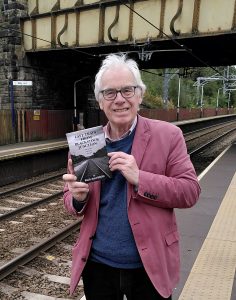
Salvo readers can get the book at a specially discounted price, courtesy of Platform 5 Publishing. Go to https://www.platform5.com/Catalogue/New-Titles. Enter LAST22 in the promotional code box at the basket and this will reduce the unit price from £12.95 to £10.95.
The Settle-Carlisle Railway (published by Crowood £24) – can do it for Salvo readers at £16
See www.lancashireloominary.co.uk for full details of the books (ignore the prices shown and use the above – add total of £3 per order for post and packing in UK)
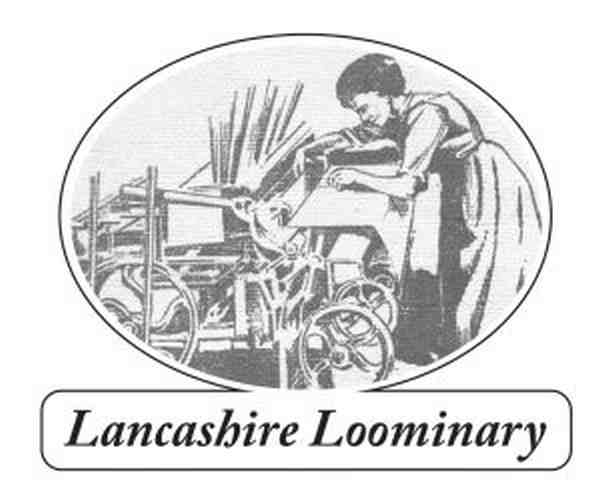
9 replies on “Northern Salvo 315”
Notwithstanding all that has already been said, I think it is wise to point out that the money for HS2 is not sitting in a room in Whitehall. The notional savings are just money that has not yet been borrowed, so any reinvestment of these funds is just a fanciful dream, until an actual commitment is in writing (not something I have yet seen) rather than notional schemes that may be supported..
Amongst railway songs you could have mentioned Flanders and Swann’s ‘The Last Train’. A fortnight ago I heard this performed with style as an unaccompanied solo by Dave Vaughan (a driver on Northern’s trains) on one of the Mid Cheshire Line’s Music Trains.
Although a poem/prose and not a song, my favourite piece of railway writing is W H Auden’s sound track to the film ‘The Night Mail’ which was produced by the Post Office for publicity purposes.
Well I’m going to come out as a former supporter of HS2, if only that it was about releasing capacity on an WCML where more freight couldn’t be accommodated, and where communities such as Bramhall and Poynton have to put up with an hourly service because Avanti take all the other paths.
That problem remains north of the HS2/classic route junction.
Yet your correspondents are right that we should doubt whether the rail schemes claimed to take the released investment will actually happen, compared with the roads element.
I’ve got a point which doesn’t relate to either railway songs or HS2, but I think it deserves to be made. It relates, basically, to right-wing media bias on transport matters (and everything else, to be honest) .
For the past few years, the railway services in the North West have suffered from an appalling level of cancellations at short notice. It has become a ‘New Normal’ to the extent that people are abandoning rail travel. It appears to be 99% caused by the incompetence of the Train Operating Companies, which in the worst cases are clearly not Fit for Purpose, and we hear stories again and again of total chaos at places like Preston and Carlisle. But we all just have to take it lying down, with little or no reference in the press. Might the Governmental and media attitude to we ‘Northern Bumpkins’ just have some bearing on that?
Earlier this year, when the rail unions threatened cancellations on a country-wide basis, it was Front Page News.
Glad to see reference to Ewan McColl’s Ballad of John Axon & Flanders & Swann’s Slow Train. Another example of the former’s lack of railway knowledge is that the Ballad contains reference to an 8F’s boiler pressure being 225 lbs per inch. Don’t forget the square, Ewan! Sorry – being pedantic!
Martin Arthur mentions the original case for building HS2 was the lack of capacity on the existing West Coast Main Line south of Crewe, and we now know that all the money spent so far will only bring a reduction in journey time from Euston to Birmingham of twenty minutes. In a country the size of the UK we do not need line speeds of much more, if any more, than the present 125mph for that part of the route. If shortage of freight paths was the problem, why not build a future-proofed 100mph freight route at a fraction of the cost. It could also be used as a diversionary route for through passenger trains. Clearly, HS2 is an unaffordable vanity project. The final point which should not be forgotten is that the HS2 trains will not be tilting like the Pendolinos, so journey times north of Birmingham will be longer, cancelling out, or worse, any gains made on HS2. Levelling up ?
Why can’t people just admit when they are wrong. The apologists for HS2 still don’t see that it was a project doomed from the start and that all the arguments in its favour, whether speed or capacity, were spurious. Such technocratric super projects are hubristic when the resources could be used to solve basic transport problems at a local level, particular in a time when environmental concerns should be THE main criteria on which the feasibility and necessity of technololgy should be assessed.
Sorry Alan, I am not an apologist but an enthusiast for HS2, and unapologetic about that. The cause is lost, but as one who was in Railtrack/Network Rail through the WCML Upgrade farce, it saddens me greatly that everyone seems to have forgotten how much pain that caused and how everyone agreed we would never conduct open heart surgery on a live main line railway again.
The basis for HS2 as proposed was capacity relief on all three main lines heading north. Government of the day insisted on pitching it as time-saving for entirely political reasons – there I would agree this was entirely wrong headed and stupid, but then we have had maniacs in charge for a very long time.
The fact that costs have overrun so significantly is partly an industry own goal, partly endless changes by Government and partly scope creep to satisfy Tory voters – like tunnelling vast quantities of it.
As originally conceived, there was an estimate that the cost premium for high speed over conventional new build was around 10% and that gave you a significant uplift in passenger capacity – why wouldn’t you?
So please, I respect your view but please also respect mine, and I believe this is a decision we will come to regret.